#Star Wars: Trading Card Game
Explore tagged Tumblr posts
Text

Star Wars: TCG - Xizor by Graysun-D
22 notes
·
View notes
Text
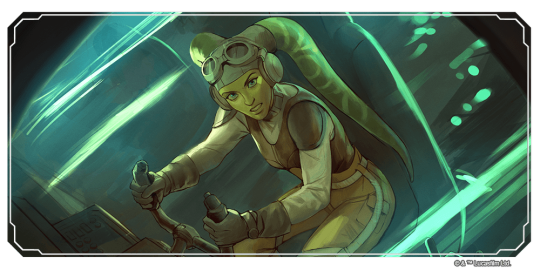
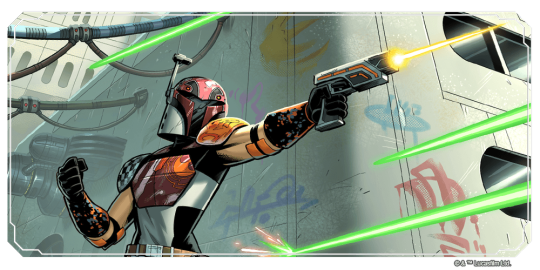
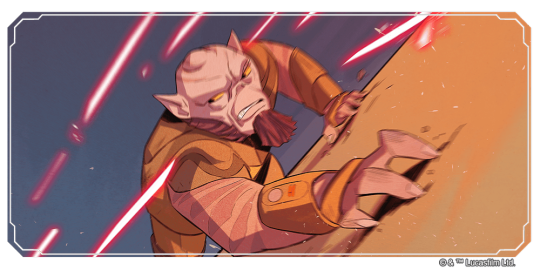
Star Wars Unlimited - A handful of Rebels
see more
#star wars#star wars rebels#sw rebels#hera syndulla#sabine wren#zeb orrelios#garazeb orrelios#trading card game#star wars unlimited#*#swu*
3K notes
·
View notes
Text
After months of painstaking work... it is finally done...




MY ART IS ON A FREAKING WALL!!!
Back in late April I was commissioned to design and paint a mural for the Trading Card Game hall at Geeky Teas and Games. It's supposed to be a Renaissance style depiction of a band of adventurers going off to slay a dragon.
The characters featured are from Star Wars Unlimited, Lorcana, Magic the Gathering, and Pokemon
This has possibly been one of the longest, hardest, and largest projects I have ever done and it's so freaking cool that something I made is now immortalized on a wall (well, at least for however long the store stays in it's current location)
So ye, this is where I've been for the past few months and why I haven't posted much art lately ^^"
also here are the concept and reference pics I drew for this


#mural#wall murals#tcg#trading card games#star wars#star wars unlimited#lorcana#magic the gathering#pokemon#pokemon tcg#the mandalorian#nissa revane#charizard#mickey mouse
26 notes
·
View notes
Photo
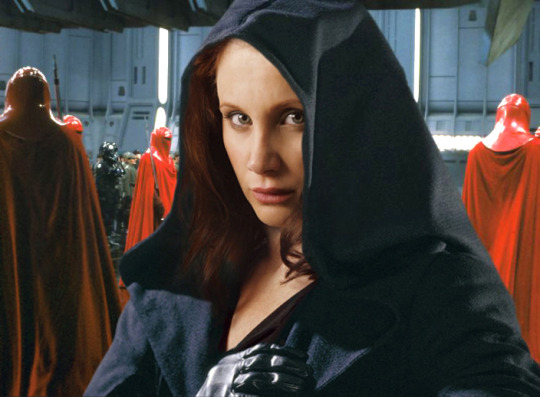
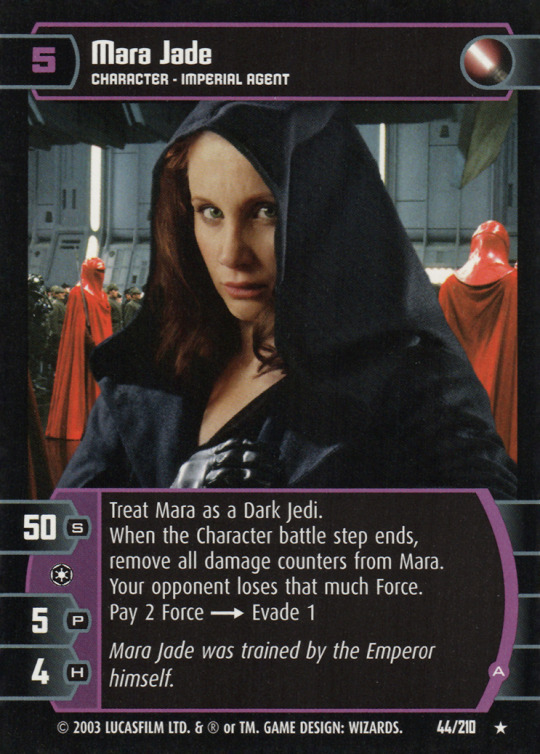


Star Wars Trading Card Game play card. “The Empire Strikes Back.” October, 2003.
The Star Wars Trading Card Game, produced by Wizards of the Coast after acquiring the Star Wars license from Decipher, featured Mara Jade in a new image. The card was produced after Mara overwhelmingly won the “You Make the Card” competition, and Wizards used Shannon McRandle as the model for Mara Jade in response to voter demand. The image was shot by photographer Ric Fogel, edited in post-production by Mark Goetz, and debuted at Gen Con in 2003. In an interview with Star Wars News Net from 2015, McRandle had these memories to share:
I was 40 weeks pregnant with my second child and Wizards of the Coast called one night and asked if I wanted to do a promo card. Of course I did, were they nuts?! I was so sick and exhausted from the pregnancy, we shot it in my basement in like an hour, and they used it on a card. That was the last time my image was taken for anything of the kind.
#Mara Jade#Mara Jade Skywalker#Shannon McRandle#Shannon Baksa#Star Wars#Star Wars EU#Star Wars Expanded Universe#Star Wars Legends#Star Wars Trading Card Game#Star Wars TCG#Star Wars art#Empire Strikes Back#Emperor's Hand
59 notes
·
View notes
Text
STAR WARS FANS
I need y'all to start getting into star wars unlimited, the star wars tcg that came out the beginning of this year, it's so good fr fr.
The 3rd set has just been released (or just about to be released in australia) and it's prequels/clone wars themed, pls it's so worth it
2 notes
·
View notes
Text




Kävin kiertämässä kirpputoreja. Tahdon Puuhamaahan pelaamaan Out Runia :<
#Kermis takes pictures#thrifting#Sega#Out Run#arcade games#Super Mario#Star Wars#Palpatine#trading cards#Virtua Fighter#Casio#suomeksi
6 notes
·
View notes
Text
trying to lesrn the star wars ccg rn (i got like 1k+ cards from a family friend) and im resding the 1998 rulebook rn instesd of the modern one bcuz i only have older cards and im having an aneurysm
2 notes
·
View notes
Text

3 notes
·
View notes
Photo

Throughout May, the folks over at Star Wars Unlimited were dropping spoilers for Shadows of the Galaxy! We got to see iconic characters such as Darth Maul, Lando Calrissian and Jango Fett as well as newcomers Rey and Poe Dameron captured in card form. Why not check the set list out over on our site?
#star wars unlimited#star wars#we love gaming#total cards#tabletop games#shadows of the galaxy#trading card games#set list#reveals#darth maul#poe dameron#the mandalorian#jango fett
2 notes
·
View notes
Text
"Anakin/Obi Wan/Yoda/Padmé/Shmi is the most tragic character in Star Wars" you are WRONG actually. L3-37 HOWEVER.....
#blah#the fact that no one ever talks about her is so messed up actually#like she is everything to me actually and what they did to her is beyond horrid#'it was life or death' IM NOT SAYING THEY HAD ANOTHER OPTION IM SAYING IT WAS TERRIBLE#this is going to get like 2 notes but i dont care because im literally right#choices were made in her creation!!!!!! she is a revolutionary!!!!!!! she values freedom for all droids more than anything else including#her own life!!!!! no matter how you feel about it they had that one like about her and lando! there is some form of jumbled emotional#romantic thread between them in some direction! and then they took this character and killed her off before plugging what was left of her#into the falcon!!! and they framed that as a good thing!!!! a GOOD THING. can you believe that?!?!?!?!#they made a character whose greatest value was independence and choice and turned them into an object to be bought and traded and bartered#and sold for ETERNITY (pretty much) and framed that as a good thing.#'this way shell be with us forever' THAT ISNT WHAT SHE WANTS#and then. and then. bc it gets worse. this cycle of buying and trading begins with her best friend (and lets be honest man she likely loved)#betting her on a card game like an object#and this will never ever be addressed#it absolutely destroys me thats what it is#SHE DOESNT EVEN GET TO DIE!!!!!!#like sw wronged her so bad and literally no one cares in universe or out except for me like 🤬🤬🤬🤬🤬#sw#solo: a star wars story#star wars#lando calrissian#L3 37
8 notes
·
View notes
Text

source
#silri#star wars expanded universe#star wars legends#star wars#legends#expanded universe#nightsister#forces of corruption#empire at war#star wars empire at war#star wars empire at war forces of corruption#empire at war forces of corruption#sith#2008#star wars galaxies#trading card#trading card game#star wars galaxies trading card game#sony online entertainment#petroglyph#video games#gaming#real time strategy#mmo#massively multiplayer
6 notes
·
View notes
Text

Kyle Katarn by Anthony Foti
#Star Wars#Star Wars: Trading Card Game#Heroes and Legends Expansion#Kyle Katarn#Jedi#Lightsaber#Sci-Fi#Anthony Foti#FFG#Fantasy Flight Games
3 notes
·
View notes
Text


Star Wars Unlimited - New Grogu art!
see more
#star wars#the mandalorian#grogu#grogu djarin#din djarin#star wars unlimited#trading card game#swu*#*
561 notes
·
View notes
Text
Opening 24 Star Wars: Unlimited Booster Packs: Pack Opening Review!
Welcome to my very first article on this blog, where I dive into nostalgia and questionable spending! I recently splurged on 24 Star Wars: Unlimited booster packs from the Twilight of the Republic set. It’s been ages since I was into trading cards—back when my childhood collection of Pokémon cards, including a battered but beloved foil Zapdos, was my greatest treasure. Now, with a “grown-up” job…
1 note
·
View note
Text
The Making Of: When I Win the World Ends
(For my previous Making Of post, see The Making Of: Cleveland Quixotic.)
I. 1999
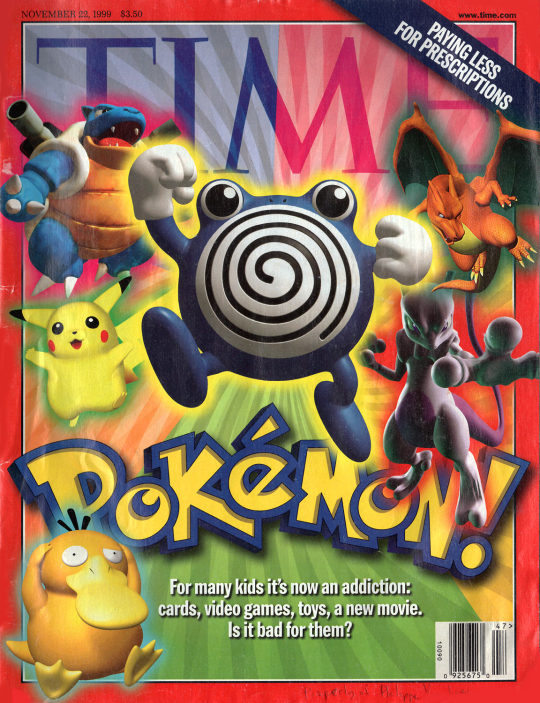
It was the year of the cubicle movie. It was the year of Fight Club, of Office Space, of Being John Malkovich, of Three Kings, of The Matrix, and of American Beauty. It was the year of suburban malaise, of eternal sunshine, of ceaseless normality. A year of United States hegemony; a year whose chief terror was that THIS WAS IT.
Before the millennium turned and the towers fell, there was an initial challenge to this order, a completely inconsequential one made consequential by a newly minted 24/7 news media machine running out of noise to fill dead air now that people were sick to bursting of the Clinton impeachment. This challenge came not through war, revolution, or violence, but through entertainment. Children's entertainment.
And I was a child. Unaware of any cultural context, I knew only one thing: I loved Pokémon. I really, really loved Pokémon.
I owned Red Version, Blue Version, Yellow Version, Pokémon Pinball, Pokémon Stadium, Pokémon Snap, Hey You Pikachu, a Pokémon Tetris sort of puzzle game, even the Pokémon TCG game for Gameboy. I had ten to fifteen strategy guides for the games, an encyclopedia of the 151 Pokémon, a choose your own adventure book, an I Spy-style book. I had Pokémon figurines, Pokémon plushies, toy Poké Balls, toy Pokédexes. I had Pokémon stamps and Pokémon stickers and a deck of Pokémon cards. Not trading cards, just a standard 52-card deck with Pokémon pictures on it. Of course I also had the trading cards. A complete set of the first three runs, plus a special Mew card you could get from I dunno Toys R Us or something as part of some promotion. I had a guide for the card game that explained which cards were good or bad even though I didn't even play the card game. I had a Pokémon Tamagotchi and Pokémon pencils and Pokémon erasers and Ash Ketchum's hat and I dressed up as Ash Ketchum for Halloween. Of course I watched every episode of the anime, and in notebooks I drew doodles of existing Pokémon and came up with names for new Pokémon. My father had died that year.
My father was a sports fanatic. Traditional sports. He, too, collected. Sports memorabilia, baseball cards, figures of famous stars. When I was an infant, he drove me on a cross country road trip to Lambeau Field in Green Bay, Wisconsin, where I became a part owner of the Green Bay Packers. He had always wanted me to grow up and pursue professional sports. When I was born, the doctor apparently said to start looking for football colleges, a quote he saved in a scrapbook of baby photos. He had played sports himself, in college; he was a baseball catcher, until a hitter accidentally struck him in the head with a full force swing.
Almost everything I personally remember about him involves him dying. He was sick for a long time, and I remember hospitals and hospital beds and strange smells and gauze. And then one day my mother told me he died.
He was a charismatic man, very social and very popular. He had many friends and a lot of family, all of whom had constantly been around our house. Once he was gone, they stopped coming around. Then it was just me and my mother, who was not a fanatic for anything, except maybe her job as an elementary school teacher, which consumed her time as she assiduously prepared lesson plans and graded tests until late at night. When my father died, she got into some argument with his side of the family, the details of which I still don't fully understand, and afterward they no longer spoke. Her own family lived far away, out-of-state, seen only at Christmas. The house became quiet.
And I… played… Pokémon.
II. The Electric Tale of Pikachu
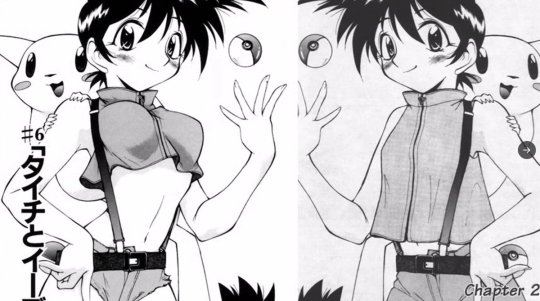
Toshihiro Ono was a mangaka primarily known for shotacon and futanari hentai. His credits such as Innyou Megami and Anal Justice made him a no-brainer pick for the officially licensed Pokémon manga, Electric Tale of Pikachu, as it too would feature a 10-year-old boy as the protagonist.
This manga would be the foundation for my conception of what Pokémon was, narratively. Though I also had the Pokémon Adventures manga that ran concurrently and which has by now long outlasted it, Electric Tale left a significantly deeper imprint on my memory.
In summary, Electric Tale is a retelling of the first two seasons of the anime. Ash Ketchum is the main character, he's accompanied by Misty and later Brock, his rival is Gary, and Team Rocket harangues him.
What sets Electric Tale apart is its tone, which is far more adult than Adventures and the anime. Obviously, part of this comes from the author's primary area of expertise being hentai. Even in the censored English version, there is a sense of sexual playfulness in how every single female character is an older woman who likes to tease Ash about his romantic interests.

But there are other elements that creep in unrelated to sex, due to the perspective of someone only used to speaking to adults who suddenly has to speak to children. Ono doesn't really get the childish fantasy of leaving at 10 being normal in society, so he introduces an element where Ash can only get a one year deferment from school and will have to return unless he hits it big. Team Rocket are former competitive hopefuls who flamed out and then, with no education or work experience to speak of, had no choice but to turn to crime. The Pokémon are depicted more realistically, often eschewing the toyetic mascot elements of their designs.

And the landscapes are often wistful, even apocalyptic in their presentation:

This more sedate, mature, realistic depiction of Pokémon became what I wanted Pokémon to be, what I projected onto an original Red and Blue version that left everything open to interpretation, and what would increasingly frustrate me with the series as it deviated more toward bombastic villain groups with goofy destroy-the-world plots. (Which was what put me off Pokémon Adventures.)
Amid all this, one panel stuck with me in particular. One panel I would think about ever since I first saw it as a child, that would turn around in my head and keep coming back. That panel would eventually—over two decades later—become the basis for When I Win the World Ends, the seed from which an entire story grew:
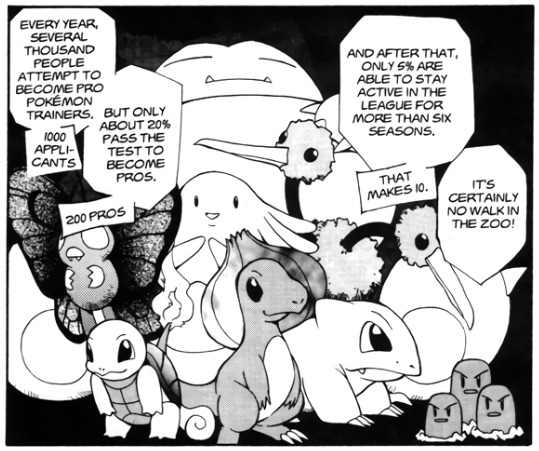
III. The Unkillable Demon King
But in the interim, the seed remained dormant. 1999 fell away. I grew up. I played later Pokémon games and increasingly lost interest by around Gen 4 and 5. Then I went to college.
That's when I started playing League of Legends.
I was something of a psychopath in college. I operated on a strict schedule and did not deviate. Wake up, read 50 pages of classic literature, write 2,000 words, go to classes, study, and then by about four in the afternoon all my obligations were done and it was League of Legends until midnight.
I wasn't actually interested in the League of Legends esports scene in its infancy. In 2012, I was actually invited to attend its World Championship in Los Angeles and refused. (When I received this invitation, I had just finished reading Homestuck for the first time, and was caught in a month-long haze in which I could do little but bask within what I considered the greatest artistic achievement I'd seen in my life. It was this month that inspired Modern Cannibals.) I only liked playing the game and watching Dunkey videos.
It wasn't until the next year, when a girl I was interested in recommended I watch, that I tuned in to my first professional League of Legends game, at the 2013 World Championship. It was there that I got to watch this new, hyped, upcoming Korean player who had apparently taken the pro scene by storm that season. That player was Faker.

It has seemingly become essential to the narrative of any sport that there is "the man who always wins." American football has Tom Brady, and the moment Brady retired, he was replaced by Patrick Mahomes. Basketball has LeBron James, picking up the mantle from Michael Jordan. It's as if someone being "the best" validates the skill-based promise of the sport, the fundamental top-down fairness of its premise, the idea that the person who wins is the best and deserved it. Faker would become the backbone of League of Legends esports and his ascendance correlated to that of the sport itself, from its humble roots at small-scale tournaments in places like Jönköping, Sweden, to max capacity arenas in the biggest cities in the world.
It's surprising, though, how the legend of Faker had already begun even before he won his first World Championship. League of Legends was designed as a clone of Defense of the Ancients (DotA), a popular mod for Warcraft III that emphasized competitive play. In its infancy, the competitive scene was mostly dominated by players who had migrated from DotA to League. They were older, winning thanks to a fundamental conceptual understanding of the game that was superior to everyone else, and frankly not very good in the aggregate. As League of Legends esports exploded in popularity from 2013 to 2015, these old pros would get filtered out swiftly, with even the biggest and most popular names retiring after only a couple of years in the scene.
Even once the new generation of League-grown talent ascended, though, careers were nasty, brutish, and short. The best players only remained on top for a season, as game patches dramatically changed viable strategies. Internationally the sport was dominated by Koreans, with the Korean regional league sometimes being seen as more difficult to win than the World Championship, where Koreans often breezed through uncompetitive Chinese, European, and North American squads.
This possibly affected the demographics of the professional scene. South Korea has mandatory military service, and leaving the pro scene to join the military was basically the end of a Korean player's career. This meant that it was rare to see a Korean player older than 25. Retiring in your early 20s was and remains common. Korean organizations, which had an infrastructural leg up on other regions due to the popularity of StarCraft 2 esports in the country, became adept at scouting promising players at 15 or 16, building them into top level competitive pros, wringing them dry for a few seasons with brutal training regimens, and spitting them out.
Faker was the exception. Though he had been discovered young by SK Telecom, a major Korean telecommunications company that did esports on the side, and gone through the training regimen, he refused to be spit out. He simply didn't stop. He won in 2013, then with a completely new four-man squad around him won again in 2015 and 2016 before narrowly losing the 2017 finals in a nail biter. Given League of Legends esports had only existed since 2011, he basically accounted for half of the championships up until that point. Nobody else, except for his teammates, had won more than once. And it was like it was known he would be this juggernaut the instant he manifested ex nihilo. Like it was known, even in 2013, that he would always win.
Then, Faker stopped winning.
By 2017, League of Legends esports was a titan. Venture capital firms, seeing the millions of eyeballs, thought that this was the next NBA in its infancy, and decided to get in on the ground floor. Multiple millions of dollars were pumped into the scene as even mediocre players in weak regions like North America pulled seven-digit salaries. In China, where League of Legends had become the national pastime, the nation's richest oligarchs ran teams for fun and vanity, outbidding Korean organizations for top Korean players in pursuit of a trophy that had gone to Korea every year since 2013. Riot, the studio developing the game, pumped tons of money into creating a professional sports product, with skilled announcers, dedicated arenas for regional leagues, live performances by musicians like Imagine Dragons and Lil Nas X, and all the other bells and whistles one might expect from a program watched on ESPN.
In this milieu, it seemed like Faker had finally reached his limit. He was still good, but not the best. Even as an individual, while everyone still considered him the "greatest of all time," he was considered outmatched by newer pros like Chovy and ShowMaker. 2018, 2019, 2020, and 2021 passed with no championships. In 2022, on a team of mostly rookies, he reached the world finals, but was ultimately beaten. Korea's stranglehold over the sport had been shaken by China, which had finally strung together some championships. People wondered if Faker would retire, although he had managed to avoid mandatory military service by representing Korea in the Olympics-esque Asian Games. He'd dealt with wrist injuries and his level of play dropped year over year. He just didn't seem to be that good anymore, potentially holding back his team of talented young players rather than leading them to victory.
Then, in 2023—
youtube
And in 2024—
youtube
In the end, never count out Touchdown Tom. 11 years of professional play, 5 world championships.
From this longwinded explanation, you might have realized that after watching that game in 2013, I became a League of Legends esports fanatic, fulfilling the prophecy set before me by my father though perhaps in not the way he would have expected.
And the things I become a fanatic about, I want to write a story about.
IV. Modern Cannibals
There's a deleted scene in Modern Cannibals, as Maximillion is driving Z. and her friends through the Utah desert. He starts to talk about Pokémon.
"I bring it up because my university thesis was about Pokemon in particular how Pokemon has basically trained an entire generation of children to think in a completely different way than preceding generations my generation for instance our fad was Teenage Mutant Ninja Turtles now I don't know how much you know about Teenage Mutant Ninja Turtles but from an educational standpoint we're talking absolute bankrupt complete and utter goose egg but Pokemon now Pokemon you see it's more like there's some substance to it you know that refrain Gotta Catch Em All right?" "..." "Well to most parents it looks like a marketing gimmick you make one hundred fifty-one characters and structure a game around collecting them the merchandising potential is astronomical kids buy one hundred fifty-one trading cards stickers coloring books figurines uh collectable lunchable toys I'm sure you've got some yourself."
He continues:
"But really you look at the game itself before the big toy explosion the game itself the focus is placed less on the collection and more on the catalogue you're given a blank encyclopedia to fill and you fill it by capturing one hundred fifty-one Pokemon but the goal is to create a complete database of each and every one and this is what I argue is the educational core of the Pokemon series." His hands left the wheel to conceive of his idea in the cool air of the car, which remained steady on its ever-forward path. "Our modern era is no longer one of singular isolated knowledge it is one of the catalogue the database which is most clearly personified in the advent of the internet because now all knowledge can be at the fingertips of any one human being all that is needed is someone to go and put the catalogue together and presto whiz bang it's there think about it Z. when you catch a bunch of Pokemon where do you store them?" Z. didn't need to think long to remember the game's mechanics. "In the PC." "Exactly now isn't that odd consider it in real life terms you have real life creatures made assumedly of flesh and bone and yet you store them in a computer how does that make sense you'd expect a farm or a holding pen but no it's the computer and that too prepares the budding portion of the millennial generation to become cognizant of the linkage between the computer the encyclopedia and the database structure of knowledge in a new era." "So," said Z. "So you're saying Pokemon taught kids how to think in the digital age?"
There's also a deleted character in Modern Cannibals. Well, mostly deleted—he still shows up, unnamed, in a couple of pages. He is Cole Coulter, Z.'s older brother, a popular League of Legends streamer. Before I deleted him, his role was to accompany Mrs. Roddlevan and Frederick in an attempt to bring Z. back home. He had POV scenes that gave insight into the weirdness of his cotravelers, but ultimately, I decided he didn't add anything to the story and removed him almost entirely.
Even then, though, I was already considering the future of Cole Coulter as the protagonist of a story about League of Legends esports. Playing under the ID MadKing, he would be a North American professional top laner, once known for his aggressive duelist style but recently forced into playing boring tanks as the esports metagame became more sophisticated and tactics-based.
The story would be simple, something I envisioned as a "sports story" only about esports instead of regular sports. It would start with Cole's team being relegated from the league, only for Cole to get a last chance signing to a new team with two promising Korean imports. One import, the mid laner, would be a charismatic and eccentric player in the mold of Doinb/Ganked By Mom/Huhi, while the other, an AD carry, would be introverted and pissy and elitist, in the mold of Piglet. The team would initially struggle, cultures would clash, then a mid-season replacement to sign a psychopathic Tyler1/Tarzaned style streamer as jungler would revitalize the team, put them on a major run, and get them to the World Championship. Though they would eventually fall after a miracle run, Cole would get a moment to truly shine on the biggest stage when he won a pivotal game by aggressive split pushing rather than tank play.
Thematically, the story would be about two things. First, a counterpoint to the idea of American exceptionalism, featuring a league where Americans are particularly bad compared to Korean or Chinese players. Second, an exploration of what it means to be exceptional at all. Cole would be an all-around mediocre person. Middling at school, at (real) sports, at the various popularity contests of being a teenager. League of Legends, this niche sub-sport, is the one thing he truly excelled at, the one place where he was good, better than 99.9 percent of all players, and yet even within that statistical greatness he wound up, ultimately, in a professional scene where he was once again mediocre, relegated to "tank duty," to facilitating other players to carry.
What does it mean to be the best? How can someone be so, so good, only to reach a level where they were still nothing special? Is there any way to win if you're not "the man who always wins"?
I remembered that panel from Electric Tale of Pikachu. The last people filtered before the final champion. It's certainly no walk in the zoo!
This idea was pretty detailed for a story I never wound up writing, something I mostly blame on the years 2018 and 2019, when a lot of bad things happened to me and in retrospect I consider it a minor miracle I managed to finish Chicago at all. As a human being, I would be decimated for the next three years, and so a lot of stories I might have written in that time never came to fruition.
Meanwhile, League of Legends esports reached a peak, then the venture capital bubble burst as investors realized there was no monetization scheme in place for any interested party except Riot Games. Money hemorrhaged out, Riot shifted resources to Valorant, and a sport that had been overinflated based on projected exponential growth in perpetuity fell back down to earth.
Also, Players came out.
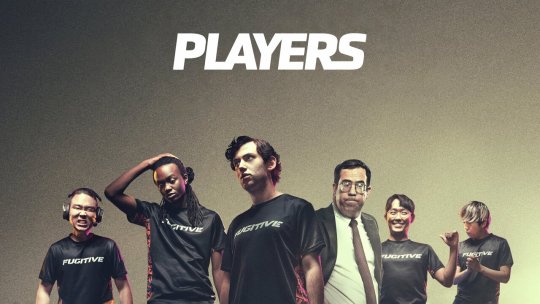
Players was a 2022 mockumentary about a fictional League of Legends team competing in the North American league. Conceptually, it was doing a lot of what I had planned for my story: following a single team on a rags-to-riches run, focusing on the interpersonal drama of the team members, asking questions about greatness and its pursuit. It's a pretty good show if you're familiar with League of Legends esports at all, with a lot of on-the-ground fidelity that gives it an authentic feel, which is exactly what I had been hoping to use my esports fanaticism to accomplish. It completely took the wind out of my sails; it was like my idea had already been done.
So by 2022, the idea of a League of Legends esports story was dead. But there was still a drive to create something with that spirit, that would delve into those themes.
What remained after all these years of sifting the sieve, letting sand slip through, was that one panel from the manga. The number of people pursuing greatness slowly filtering until only one remained. And if I wasn't going to pursue that idea through League of Legends, maybe I could pursue it through another vehicle. Maybe the vehicle through which the idea had originally been exposed to me. Pokémon. It all came back to Pokémon.
V. Everything Evolving Into Crabs
I knew immediately that if I were to write a Pokémon fic, it would be a tournament arc. This was the natural evolution of my esports story idea. Also, if I were to write Pokémon, I wanted it to be a story about utopia, immersed within Pokémon's near-future ideal world, where everything is clean and healthy, where society is neat and ordered.
This idea caused me to remember the novel Eyeless in Gaza by Aldous Huxley, which I had read a few years back. A mostly autobiographical bildungsroman written on the precipice of World War II, the novel ends with the young protagonist on a journey to Central America, where he meets an idealistic doctor who believes sport to be a proper substitution for war. He tells the story of two tribes locked in internecine conflict through generations, able to replace that violence with soccer matches.
And wasn't that what the world of Pokémon was, a utopia revolving around neutralizing weapons of war by using them for competitive sport?
This tournament, I envisioned, would not simply be about deciding who was best, but an ideological battle for the future of the Pokémon world. To that end, I imagined a war between an entrenched trainer class, who competed as philosopher-warriors, intense individuals with deep connections to their Pokémon, and an upstart commercialization that sought to replace the ideological underpinnings that made their society so safe and prosperous with economic accumulation. It was from this kernel that the character who would become Aracely Sosa arose: charismatic, appealing, human-empathic, and propped up by a support staff who did all the hard work of teambuilding for her.
I imagined the story having an ensemble cast, focusing on nearly every competitor equally, with the Aracely character not having any especial focus until her improbable rise to the top. I imagined a final round where she faced off against "the man who always wins," and though she would lose to him, she would seem to have won the ideological battle, altering the course of society as major corporations scrambled to employ her formula for success at a much grander scale. The story would end with this realization of the earth-shattering importance behind her run, only for Aracely to sink in disappointment. Because in the end, all she really wanted was to win.
The more I thought about it, though, the less I liked the idea of an ensemble cast. The ensemble cast element of Chicago hadn't gone over very well (though I like it), and I figured it would wind up inflating the length of the story considerably. I was coming to the end of Cleveland Quixotic, after all, and once more wanted to write something smaller, tighter, and denser.
So I oriented my thinking to instead have the story revolve around Aracely and one major rival, to give an interpersonal mirror to the ideological war being waged. Thus, Toril came about as an antithesis to everything I had imagined Aracely to be: gruff, antisocial, independent. Their rivalry would culminate in a semifinals battle, before Aracely went on to fight "the man who always wins" in the finals.
I forget exactly when the gender theme came into the equation, but it evolved as an outgrowth of (once again) my competitive League of Legends expertise, where women are essentially nonexistent despite there seemingly being no biological blocks against them. This dovetailed nicely with Pokémon, a world where women seemingly could be powerful competitors, but where—in the anime at least—none ever are. For instance, look at this chart of every major tournament in the anime:

Every known winner is male. Every known finalist and semifinalist is male. Only a handful of female characters have reached the quarterfinals. What possible in-universe justification could there be for that?
This question was actually far more prominent in early planning and drafting than it wound up being in the final work. Initially, I had Aracely's personal motivation revolve around a drive to be the first female trainer to win; this would increase the ideological conflict between her and Toril, who attempted to ignore that she was female altogether. Over time, this theme would see diminished importance in face of the last piece of the thematic puzzle: cults.
It came from reading Underground by Haruki Murakami, a nonfiction journalistic account of the 1995 Tokyo sarin gas attacks carried out by the cult Aum Shinrikyo under the direction of its leader Shoko Asahara. Japan in the 90s was experiencing its own End of History, one taken literally by those disaffected with modern society's grand narrative. The prophecies of Nostradamus became fashionable among the young, who believed that 1999 would be the final year before the world was destroyed. Murakami interviewed both survivors of the gas attack and members of Aum Shinrikyo, collecting worldviews of people who simply thought they were "different" and who were willing to give everything in their lives to the one place that seemed to accept that difference.
The 1995 attacks were a watershed moment in Japanese culture. In their wake would come pivotal works of Japanese pop media, like the titan of otaku culture, Neon Genesis Evangelion:
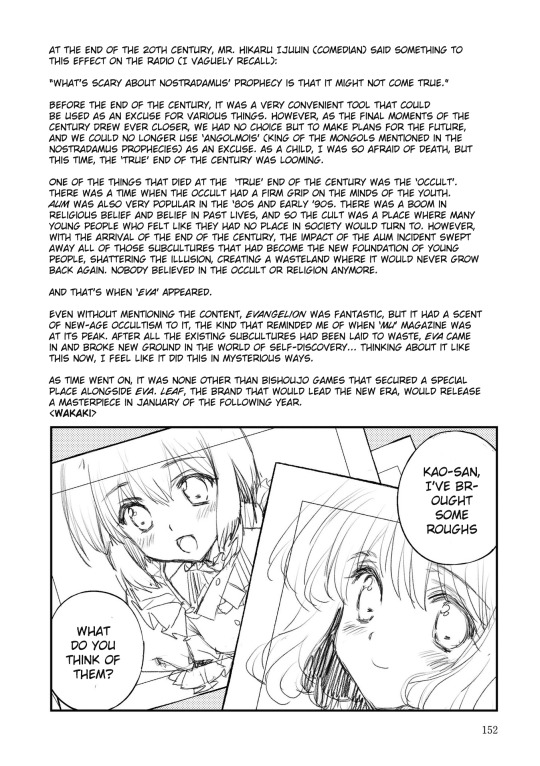
(What's scary about Nostradamus' prophecy is that it might not come true. A year whose chief terror was that THIS WAS IT.)
Pokémon, whose first games released in Japan in 1996, also emerged within this post-Aum world where fixation on the minutiae of pop media was becoming a primary pillar of meaning for the youth, and it's hard not to see echoes of cultism in the evil teams that dot the series' landscape. Even Team Rocket, originally more modeled on organized crime than occultism, veers that direction in Gold and Silver, and afterward the organizations and their world-ending plots become increasingly absurd, to the point where it starts to become unclear why anyone would ever follow, say, Lysandre.
As I mentioned earlier, my personal interest in Pokémon was at odds with these clownish, Saturday morning cartoon villain organizations, but Murakami's account of the Aum attacks recontextualized them for me, made them make sense even within the framework of a "realistic" utopian world. The last elements snapped into place, and I knew my main character would be the member of one of these cults. A cult dedicated to, what else? Evolution. A core element of the Pokémon series, a perfect metaphor for the frustrating lack of movement of the End of History 90s. I imagined a cult leader as a surrogate mother figure for Aracely, who would have a strained relationship with both of her own parents, and deciding on that, the idea of making Pokémon's canon evil mother Lusamine the villain was a no-brainer. I imagined a post-SuMo Lusamine, unable to move on from her experience merged with Nihilego, languishing in Kanto after being sent there to consult with Bill, who had his own experience being merged with a Pokémon... It didn't take long to figure out how all these pieces connected.
The full form of the story had taken shape.
VI. Showdown
I knew immediately I would be following Showdown rules for the battles. No alternative even crossed my mind. I had dabbled in Showdown a few times over the years, first in Gen 3 OUs, then later in Gen 7 OUs, and I knew from experience that Pokémon is a monumentally more interesting competitive game when operating at a high level compared to either its depiction in the anime (shounen logic, mid-fight evolutions) or the general playing experience (spam your best move on your overleveled starter). I knew I would use competitive rulesets before I even considered the thematic or worldbuilding aspect I would eventually take in the story itself (i.e., that the specific rulesets prevent battles from becoming bloodsport and enforce order on the world). I simply thought doing battles this way would be far more entertaining.
To prepare, I started playing Gen 9 OUs under the guidance of a few friends who were into the competitive scene. I grinded the ladder for months, eventually getting a good enough grasp on the metagame to reach 1500 Elo on the Showdown ladder, which is not very good but generally higher than someone can reach with dumb luck.
Crafting the tournament format and rulesets used in the story wasn't difficult. I modeled the tournament format on the League of Legends World Championship, with region-based seeds (having been selected due to performance in regional tournaments) competing in four groups before the highest performers advanced to a single elimination bracket. Initially, I envisioned a 32-competitor bracket instead of the 16-competitor bracket that would appear in the final draft, but otherwise the format came quickly and easily.
In terms of the rulesets and available Pokémon, my considerations were made primarily in terms of what would be most entertaining to read. I decided to include Mega Evolutions and not include Z Moves, Dynamax, or Terastallization, because Mega Evolutions are cool and those other gimmicks are not. The bring-9-pick-6 format, while unusual in Showdown rulesets, is similar to the rules in Pokémon Stadium and VGC tournaments, and also adds a level of intrigue to which Pokémon each competitor uses. (It also enabled Red's Zapdos at the climax of the story, which was something I knew I would bring out from very early on.)
With the help of one of my friends who knew competitive Pokémon, I scripted out each battle assiduously before I wrote them. Every battle was tested using Showdown itself, with only a few turns mocked up to account for luck. For instance, in Aracely versus Jinjiao, Slowking is meant to stay asleep for three turns. Rather than rely on luck to ensure Slowking actually slept that long during the test, I could give Slowking a useless move and have him use that instead to simulate being asleep.
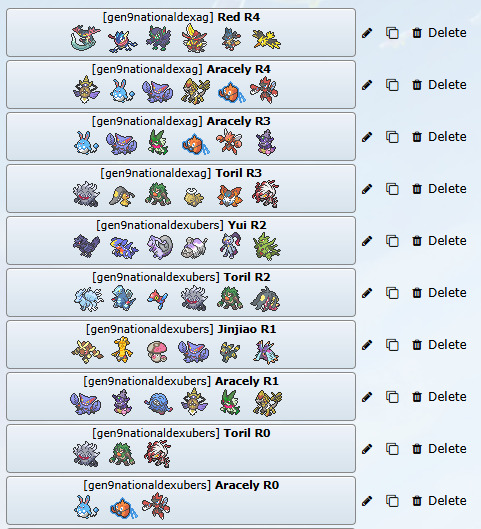
The only thing that couldn't be tested in Showdown was the 7 PP Kingambit trick Red uses at the end of the story, because it's impossible to set a Pokémon to have fewer than max PP in Showdown. This led to one of the bigger mistakes of the story, as it turns out that Encore would simply wear off if Kingambit ran out of PP, rather than forcing him to use Struggle like I assumed. Luckily, even if this were the case, it wouldn't change the outcome of the battle, so it's not an error I lose too much sleep over.
Character teams were chosen to thread the needle between a few considerations. The team needed to be competitively viable, reflect the character's personality in some way, and be distinct from other teams for the sake of variety. (Variety is somewhat unrealistic in real top-level competitive Pokémon, where you'll often see many almost identical teams in the top ranks. But that would be boring.) Some lack of optimization was allowed under the conceit that actually training these Pokémon to peak form would take a lot of time in the real world, compared to Showdown were optimization can be determined quickly due to the ability to immediately adjust stats and builds.
I also tried to give some preference for Pokémon that would be more familiar to layman fans, though this was difficult because Gen 8 and 9 have outrageous power creep and many popular early generation Pokémon have been completely phased out. (Using Megas helped with this issue.) It was this consideration that led to Azumarill being Aracely's ace. There was also an innate challenge to imagining what the competitive scene would look like without legendary Pokémon. Zapdos and Landorus-Therian have been inexorable staples of the competitive scene for generations. What happens in a world where they aren't used at all?
In the original 32-person bracket, I imagined Aracely competing against Jinjiao in the first round, then minor characters Adrian da Cunha and Jacq Ray Johnson in the next two rounds, before facing Toril in semifinals. I imagined Adrian da Cunha as a "hometown hero" whose team wasn't great but he was plucky with a lot of grit, and Jacq Ray Johnson as a self-aware heel who liked to use cheesy strategies and gimmicky Pokémon like Smeargle and Ditto. Condensing from 32 to 16 occurred around the same time I had settled on Lusamine as my villain/cult leader, which led to replacing those two with Gladion. I developed full brackets for both the 32-man and 16-man iterations, with character names and regions, just in case I ever needed to mention them.
All that was left to do was write the story.
VII. Unbroken Line of History
I began writing in September 2023 under the tentative title Unbroken Line of History, which I would later change to simply Lines. In the original drafts, I opened the story with a modified version of the panel from Electric Tale of Pikachu detailing how people are filtered over time in their pursuit of being the best, this time starting with all 8 billion people in the world until only one remains. The story then cut to Aracely's perspective in the restroom as she mentally prepared for her final group stage match.
At this point I was more set on Aracely being the clear protagonist of the story, so she had a few facets of her personality designed around that. First, as I mentioned before, there was a feminist angle where she was motivated specifically to be the first female trainer to win the championship. Secondly, I threw in some more generic nervousness/fear of failure. The other major difference is that I did not lead with the cult prophecy of the world ending. I originally envisioned the cult reveal to be a mid-story twist, and only obliquely hinted at it.
The scene still played out with Toril appearing and the two getting off to a bad start. Then, Cely's father tried to talk strategy with her while she ignored him, before the battle transpired in much the same form as it does in the final draft.
I showed this early draft to my friends and most disliked it. My girlfriend at the time told me Cely sounded like an edgy 13-year-old boy, while my neuroscientist friend whose aspirational idol is Bondrewd from Made in Abyss wanted to know more about the oblique hints of a cult, finding everything else boring. Another friend said it was stupid that there were 30 seconds between turns during the battle and that the Pokémon should just go at each other; nobody would actually want to watch a battle that was paced so slowly. (I vehemently disagreed with that take. Basically every popular sport balances between slow-paced moments of strategy and fast-paced moments of action and execution.) Some people I showed it to did enjoy it, though. Gazemaize, the author of Chili and the Chocolate Factory, was especially enamored by the Brittany/Gardevoir reveal and the Bud Light Analyst Desk, and implored me to keep both of those elements at all costs. 7th, one of my friends who helped me with the Showdown stuff, was so into it she drew fan art of all the characters (which I've posted before) and also wrote eight pornographic short stories about them.
I rewrote the same opening scene several times across October and November, though these were minor iterations without significant adjustments. Frustrated with the lack of progress, I decided to take a break from writing to simply think about the story for a few months.
During this time, to fix Aracely's edgy 13-year-old voice, I decided to lean into her being from Pokémon Los Angeles (with her native region, Visia, being a play on "visual" as a reference to Hollywood) and gave her a Valley Girl accent. To prepare for this, I listened to hours and hours of ASMR videos of people speaking like Valley Girls and took notes on their inflection and syntax. It was here where I decided on Aracely's underlining quirk, as a way of capturing the unique style of emphasis Valley Girls used.
This also made me realize I needed to adjust Aracely's personality. Despite the tone of her voice, she was still acting antisocially. She didn't want to talk to her father, she didn't want to talk to Lachlan Nguyen, she didn't even really want to talk to Toril. Toril herself was a lump of coal. My own misanthropy kept leaking into the characters, even when I conceptually didn't want them to have it. I thought back to Cleveland Quixotic, and how what made the Jay and Viviendre romance work was that they actually both liked each other, and figured—even though I didn't have explicitly romantic plans for Aracely and Toril—that I needed to do something similar to make their rivalry truly pop. Rather than avoid people, Aracely would lean into talking to them, even if they were annoying. Although Toril remained frigid, there would be a part of her yearning for emotional contact, a way to coax her out of her shell.
I also thought deeply about the structure of my stories in general, and my inability to come up with good hooks. It was around this time that someone I knew was reading Chicago. They pointed out that the plot of Chicago doesn't really start until Chapter 26; that I was "burying the lede." I considered this. My logic, when writing Chicago, was that the Empire moving to take over Washington would be a twist, something that would shock and excite people and change their perception of the entire story.
But did that make sense, when really the story was "about" that twist? Didn't that just make everything before the twist harder to get into for a reader? Chicago might look radically different if I revealed the Empire's goals immediately, but it would also probably be a more immediately engaging work. I'm a big fan of delayed gratification in storytelling, but had I taken it too far?
This was a major revelation for me, and immediately I understood what I needed to do for my Pokémon story: move up the cult plotline. Place it front and center. Name the whole story after it even. I decided on framing the opening scene from Toril's perspective, depicting Aracely initially more as an alien other, emphasizing the fact that she was in a cult rather than hide it behind foreshadowing. This could also lead to Aracely and Toril having more of a dual protagonist setup, which would make my planned two-half finale (one half where Aracely battled "the man who always wins," one half where Toril got involved in stopping the cult's doomsday plot) work even better.
Confidence resurged. At the end of January 2024, my girlfriend of seven years and I broke up. A few days later, I started writing the sixth—and ultimately final—draft of When I Win the World Ends.
VIII. When I Win the World Ends
Now it's the part of the Making Of where I actually make the thing I'm supposed to be making, but there's a lot less to say about it. Once I have a plan, the actual writing of the story is the easy part, and most of what I wrote—with a few exceptions—looks similar to the story as it exists now.
There were some oddities. I wrote the first seven chapters (everything up to the end of the Jinjiao battle) and then had to take a two week break to write a short piece for a writing contest I had entered in December as part of an effort to stop overthinking WIW. After this interruption, I returned to WIW writing perhaps a bit more perfunctorily than I usually would, leading to an original version of Chapter 8 (the chapter where MOTHER makes her first real appearance) that was short and abbreviated. Later, in editing, I would rewrite most of this chapter.
A few ideas emerged while writing, like the motif of serendipity/Logos, which I felt tied nicely to the ideas of evolution and history. It was also in this draft that I introduced Cely's friends Haydn and Charlie, as a nod to an earlier work of mine also featuring a fashion-obsessed girl from Los Angeles. (Speaking of nods to earlier works, in the original 32-man bracket, Cole Coulter featured as one of the competitors, but he didn't make the 16-man cut.)
The process went smoothly. I finished the draft at the end of May, a little under four months after I started it. I had envisioned the full story as being about 70,000 words, but the draft ended up closer to 115,000. Underestimating story length is just an essential element of the trade, though.
A few days after finishing the draft I went on a four-day Oklahoma Darkness Retreat where I had access to zero electronics. The goal was to think about my story deeply and how it could be improved in the editing process.
In this time chamber, where I did nothing except complete crossword puzzles and read The Recognitions by William Gaddis, I came to a realization. There was one element the story needed that wasn't already there.
That element was Sabrina. In the original draft, Sabrina was not present during the scene where Aracely meets the Old Man. She was mentioned obliquely a couple of times in conjunction with Aracely's "psychic powers," but it never really built to anything. There was still a scene where Aracely was interrogated due to her relationship with MOTHER, but only by nameless goons, and the scene lacked tension as it was clear Aracely could talk circles around them.
When I returned from Oklahoma, I prepared for my conception of Sabrina as a character by writing an 8,000 word short story from her perspective, which hashed out an entire backstory for her. Then, I started editing the draft.
For me, a lot of editing is just polish. Usually, cutting out needless sentences and fixing clunky ones, as well as emphasizing a few of the more understated themes and motifs. For instance, during editing, I made slight additions to emphasize the thematic connection between Aracely's suicide attempt and the global war that almost destroyed the world, as well as the connection between the moon and cyclical insanity (lunacy, etymologically, being related to the moon). I made the Old Man more of a Walt Disney-esque figure (from my notes: "a dying Disney"), rewriting much of his dialogue to either be direct quotes or to evoke his ideals. I also expanded on several of the scenes where Toril and Aracely interact to make their relationship more complex and nuanced. I gave MOTHER some new dialogue, including her speech in Chapter 18 about loving a child for the potential it promises, while also paradoxically wanting it to remain a child forever.
The largest changes were in the three chapters I almost fully rewrote. The first was Chapter 8, which as I mentioned earlier was overly terse. In the original draft, it depicted MOTHER as more pathetic, more dependent on Aracely. I decided to make her a more threatening figure, and incorporated a few references to the Moloch sacrifice scene from Valle Verde to make her seem more like a false idol. Similarly, I rewrote Chapter 12, which was originally a very short chapter that focused solely on a conversation between MOTHER and Nilufer that ended with the order to kidnap Aracely. In rewriting the chapter to include Fiorella, I gave myself more opportunity to flesh out the respective philosophies of her and MOTHER (including some of the story's most salient discussions about why cults exist), as well as give more of an insight into the inner workings of RISE as an organization. And lastly, I fully rewrote Chapter 19 to include Sabrina.
The last changes I made in editing were to the final chapter. When I finished the final draft of the story, I sent it to several readers, many of whom had looked at the original drafts of the first chapter, as well as julirites, the author of a Fargo fan fiction called London. There was an immediate and minor backlash to the final chapter, which was originally much more pessimistic, from most people who read it. In the original version, Aracely and Toril were not still in communication. (Fiorella was also dying of cancer instead of jockeying to replace the Old Man.) The finale had a much more somber, sedate, tragic note. Juli and 7th disliked this sad ending, while Gazemaize wanted me to cut the final chapter altogether. I felt confident that the final chapter was necessary, though, and revised it to its current version, which was much better liked.
And then... the story was finished, near the end of July. I crunched the numbers and realized that if I posted two chapters to start and then did a twice-weekly posting schedule, I could end the story serendipitously on October 12. So I did.
IX. Names and Special Thanks
In my Making Of post for Cleveland Quixotic, I had a fairly extensive list of where I got all the character and place names from. The list is a lot less extensive here; most names I constructed for the purpose of sounding evocative, rather than taking them from someplace specific. For instance, I chose the name Aracely Sosa because it sounds like whistling with its repeated S sounds, compared to Toril Lund which is a lot harsher with its consonants. You can see a similar rationale behind names like Fiorella Fiorina, Yui Matsui, and even some of the background characters, like Jacq Ray Johnson, Jr., where there is a lot of emphasis on alliteration and rhyme.
There are a couple of exceptions. Jinjiao is the in-game ID of a longtime Chinese League of Legends pro of middling notability. He picked the name (which means "Golden Horn") as a reference to the Golden Horned King, a villain from Journey to the West.
Lutz, Fiorella's cameraman, was named after an extremely minor character from Fire Emblem: Path of Radiance, who is not playable and only appears in a singular cutscene before being killed. They are so irrelevant that despite naming a character after them, I actually forgot their name, which is Lotz, not Lutz.
Haydn is named after the famous classical composer.
Special thanks to 7th and Elick320 for helping me with the teams and battles. Thanks to Gazemaize and julirites, among others unnamed, for reading and providing feedback. And thank you all for enjoying the story.
#when i win the world ends#wiw#bavitz#the making of#writing#pokemon#fanfic#fan fiction#league of legends#faker#the electric tale of pikachu#Youtube
163 notes
·
View notes
Text
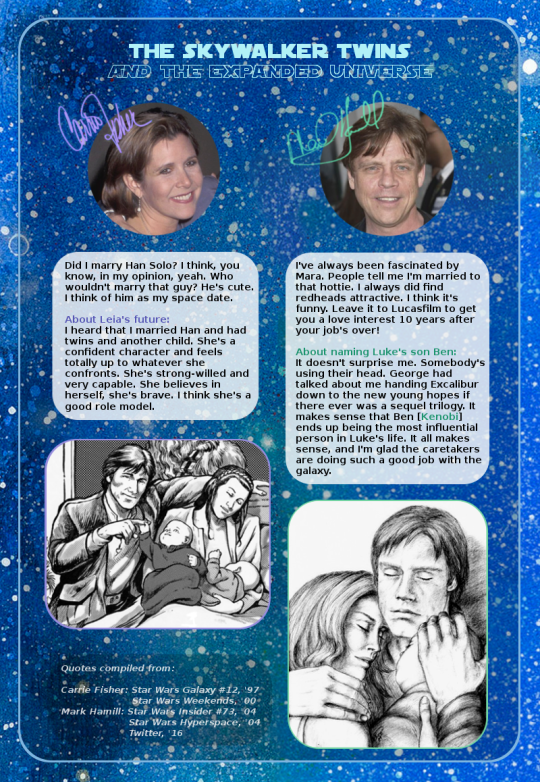
The Skywalker Twins and the Expanded Universe This graphic pulls together quotes Mark Hamill and Carrie Fisher have made over the years regarding their characters' futures in the EU. Although neither of the two actors were readers of the EU material, they knew of the goings-on of their characters through friends and family informing them of the events of the novels. Carrie was said to have picked up a copy of Courtship of Princess Leia in the '90s due to liking the cover art. In 1997, she was interviewed for Star Wars Galaxy #12, where she provided some remarks shown here; later, in 2000, she also commented a bit on the subject of Leia's EU life at the Star Wars Weekends event at Disney Hollywood Studios. When her fictional twins of Jacen and Jaina were brought up, Carrie asked if they behaved themselves, and when an audience member said they did not, Carrie quipped, "They don't behave, seriously? That sounds like they'd be my kids." Carrie would sometimes remark that her preferred lightsaber color would be purple, if she was to have one; the closest this came to being realized is Leia's reddish-pinkish (nearly purple) lightsaber, as presented on the Japanese and American covers of Star by Star, in the New Jedi Order. Mark has remarked over the course of several years on his EU self, repeatedly commenting that he approved of Luke's relationship to Mara. In 2004, Mark even took to the stage with Shannon McRandle, Mara's actress for the trading cards; Shannon says they got along well, and Mark enjoyed meeting her, with him saying later to Insider, "The model who plays her is just adorable." The quotes compiled here for Mark's section are from Insider #73, from 2004, a Tweet of his from 2016, and a Hyperspace chat Mark conducted with fans in 2004. Three pieces of art were used to create this piece: the immaculate Star Wars #20 by Hugh Fleming for the starfields, a piece illustrated of the Solo family for West End Games' The Last Command Sourcebook, and a drawing of the Skywalker family by FalconFan on DeviantArt.
#sw legends#star wars legends#sw expanded universe#star wars expanded universe#star wars eu#luke skywalker#mark hamill#carrie fisher#leia organa#leia organa solo#princess leia#mara jade skywalker#mara jade#ben skywalker#jacen solo#han solo#jaina solo#anakin solo#hugh fleming#falconfan#courtship of princess leia#shannon mcrandle#skywalker twins#infographic
69 notes
·
View notes